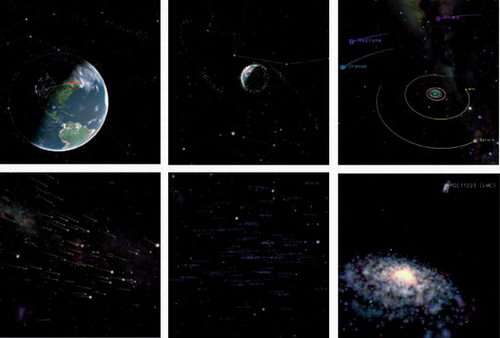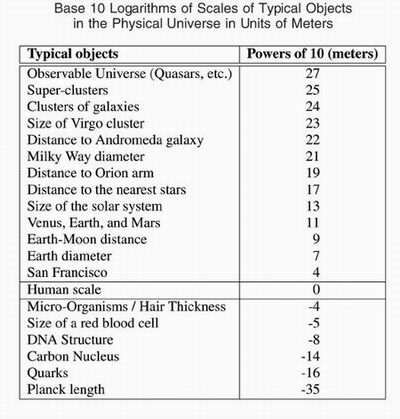January 18, 2007 feature
In 'forty jumps,' scientists model scales of quarks to quasars

Comprehending the smallness of a quark or the hugeness of the observable universe is a challenge that most of us find difficult, yet captivating. Placing vastly different scales side by side to explore their relationship amounts to a task not even computers have mastered efficiently. Recently, scientists Chi-Wing (Philip) Fu and Andrew Hanson have developed a visualization system of the universe that may help scientists, educators and film viewers better understand size on a journey through the universe.
“Graphics displays have faced a limitation due to their digital nature,” Hanson explained to PhysOrg.com. “For example, handling large ranges in detail is out of the range of standard hardware, such as accelerated graphics cards. With this new system, we can create an accurate, interactive experience, with continuous scaling over different scale ranges. You can wander continuously throughout the universe without any anomalies.”
Fu and Hanson’s work tackles several problems that past systems have faced: focusing on objects at different distances, depth perception, and speed. As Hanson explains, it’s a bit like looking at a ladybug on your nose with the galaxy in the background. To improve these areas, the scientists developed a graphics software system that provides a continuously scalable visualization in three dimensions.

Because a normal “zoom” feature would take an impractical amount of time due to the vast precision required, Fu and Hanson used a new approach: power-scaled coordinates (PSC). The scientists were inspired by a film called “Powers of Ten” by Eames and Eames, which itself was based on the 1957 children’s book Cosmic View: The Universe in Forty Jumps by Boeke.
“We asked ourselves, ‘how do you provide that experience [of the film]?’” said Hanson. “We extend that ‘powers of ten’ framework by making this system interactive instead of pre-computed and pre-stored.”
Fu and Hanson’s PSC system works by representing coordinates and vectors using logarithmic scaling methods, enabling the system to handle all scales in a single context for interactive control by the user. One of the novel PSC-based ideas in the architecture is a “depth rescaling method,” which can project objects across extreme scales with the needed precision by distorting the vertices of distant background objects.
Also, to accelerate the rendering of objects during navigation, the system uses “environmental caching” and “object disappearance” to develop pre-rendered backgrounds and ignore objects that are not large or luminous enough to appear on the screen. On a desktop computer, the program achieves interactive speeds.
The content of the system—stars, galaxies, supernovae, etc.—comes from an extraordinary collection of data from exploration systems such as the Sloan Digital Sky Survey, the Bright Star Catalogue, Hubble and other telescopes. In their study, Fu and Hanson present a “powers-of-ten journey,” starting, e.g., from Earth (107 m) up through the solar system (1013), the Pleiades cluster (1018), the Andromeda galaxy (1023), and beyond (see figure).
Like previous computer graphics programs studying outer space, Fu and Hanson predict that this system could not only have use for astronomers and physicists studying the universe, but for educational and commercial purposes, as well. IMAX shows and planetarium presentations have excited young enthusiasts with their realistic animations, and as computational power continues to grow, the public can also benefit from Fu and Hanson’s scale visualization technology.
“Our motivation was to create a framework for a real-time digital planetarium,” said Hanson. “With this framework, we’ve created a series of layers of objects across an enormous scale range, all on a single screen.”
Citation: Fu, Chi-Wing and Hanson, Andrew J. “A Transparently Scalable Visualization Architecture for Exploring the Universe.” IEEE Transactions on Visualization and Computer Graphics, Vol. 13, No. 1, January/February 2007.
By Lisa Zyga, Copyright 2006 PhysOrg.com.
All rights reserved. This material may not be published, broadcast, rewritten or redistributed in whole or part without the express written permission of PhysOrg.com.





















